This was published 9 years ago
Vienna, Austria: Polaroid photo walking tour
A walking tour of Vienna, Polaroid in hand, creates long-lasting memories for Kerry van der Jagt.
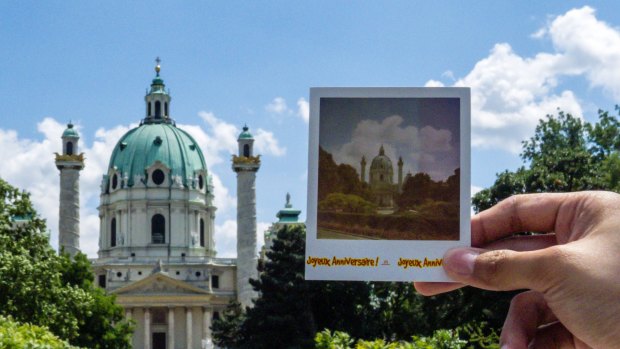
Snapped: A karlkirche (church) is captured for posterity.
I'm in the courtyard of Vienna's MuseumsQuartier, the cultural plaza where traditional baroque meets the avant-garde. It's a glorious summer's day and most people are stretched out on Enzi chairs, those colourful, cult-classic sun loungers for which the plaza is known. While some couples kiss and canoodle, many are on smartphones, heads down, fingers and thumbs tap-dancing across brightly lit screens. Others hold their phones aloft for the ubiquitous selfie, a portrait destined to be artfully aged and added to the other 500 million or so photographs uploaded to social media each day.
Through the viewfinder of my camera I swing past the bright young things, past the children playing and the old men sleeping, settling instead on a tight shot of the sign on the wall of the Museum of Modern Art (mumok). The bold letters set against dark basalt blocks seem to represent the blending of Vienna's past with its cutting-edge present. I squeeze the shutter, a reassuring click and whir producing a palm-sized rectangle of film. A memory in the making.
Before Instagram and Hipstagram there was Polaroid, that instant film so popular in the 60s and 70s, which conjured up pictures before our very eyes. The images were far from perfect, often too dark or blown out, but it was the closest thing to magic we knew. I can still recall my own mother with a borrowed Polaroid producing pictures with a magician's flourish on a family outing to the zoo.
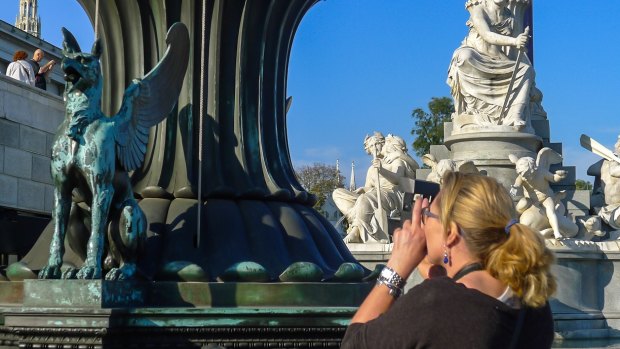
Snap happy with a Polaroid.
Magic and mystery was always part of the charm but the digital age put an end to that. The company, Polaroid Corporation, which was started by Edwin H. Land in 1937, first went bust in 2001 and again in 2008. "Enter an Austrian scientist, Florian Caps, who bought the fabrication plant in The Netherlands and saved the day," says Thomas Preyer, guide and owner of Polawalk, an instant-photography walking tour he co-founded in 2013.
Together with my husband, I've joined a small group of Australians, New Zealanders and Americans who have signed up for the two-hour walking tour with Preyer and business partner Gilbert Lechner. With a couple of free days in Vienna before a cruise along the Danube River to Budapest, the tour is an ideal introduction to the city.
"Everyone told Caps it would be impossible to resurrect the chemical process," Preyer explains. "So he joined forces with Andre Bosman, a Polaroid employee charged with shutting the factory down, and founded The Impossible Project." By 2010 the Impossible team had created a new instant film that would work in classic Polaroid cameras, of which it is estimated there are 300 million world-wide.
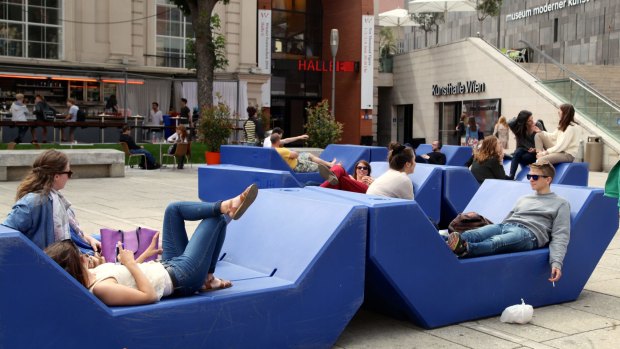
Eras meet: Modern Enzi chairs in the old MuseumQuarter.
Preyer hands each of us a vintage box type 600 Polaroid camera, together with some practice film. With the focal length and exposure set I squeeze the shutter, the film producing, not a picture but a hand-written note, "Smile like you mean it." Five minutes later, with the proper film loaded I'm still smiling, as I click off my first shot of the Museum of Modern Art. I feel like I've been granted eight magical wishes.
From the MuseumsQuartier we head towards the newly chic area of Spittelberg, known to locals as the village in the city. What was the red-light district in the 18th century is now Vienna's artistic heart, a creative hub of design studios, galleries, cafes and bars. One woman in our group is so taken with the graffiti art she blows off all of her shots in 10 minutes; another is drawn to architectural detail such as iron fretwork and clock faces. I decide on two classic street scenes, a wide shot showing the cobblestones, lamp posts and elegant Biedermeier buildings and another of a bicycle propped against a wall advertising fresh strawberries. Three wishes down, five to go.
"I love the idea of visitors crafting their own souvenirs," Lechner says. "Much better than a Mozart coffee mug." While our tour concentrates on urban Vienna, Polawalk also offers tours of the seasonal Christmas markets, Madam Tussauds or a typo-walk focusing on signs and lettering.
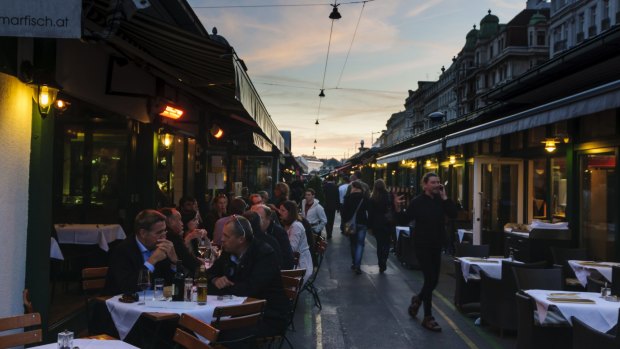
Lively: Naschmarkt is abuzz in the dusk.
Lechner leads us to a small plaza where we stop to fill our water bottles from a centuries-old fountain. Overhead a middle-aged couple looks down at us from their narrow balcony, chatting quietly while enjoying a glass of wine in the afternoon sun. A simple scene, unremarkable, except it is bathed in a light so golden it could have been spun by Rumpelstiltskin himself. With a nod and a wave I snap my fourth memory. And that's the beauty of Polaroid film; with its limited number of shots it forces you to slow down and to pay attention to the small things. It's also a novelty, bringing out smiles and genuine interest wherever we go.
I hand the camera to Preyer, asking him to take some pictures of my husband and myself. Shots five, six and seven fall quickly. He snaps one of us in front of an old photo booth and another two when we stop at a café. "The tour is about preserving memories in a tangible way," Preyer says. "Giving people something unique to take away."
I save my final shot for the Naschmarkt, a produce market that has operated on the Wien River since the 16th century. "Look for contrast and colour," suggests Preyer. "Keep your eyes open for strange or awkward things." The rows of fruit and vegetables provide the colour, but when a burly guy wearing a hand-knitted vest pops up out of his spinach patch, and begs me to take his photograph, I have my wished-for 'strange'.
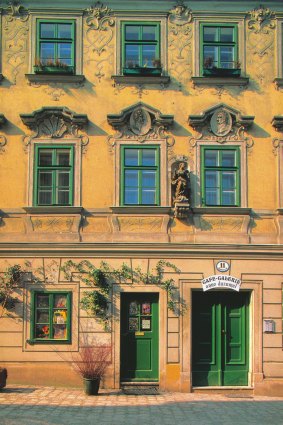
Golden memories: A baroque house in Spittelberg.
Back at our hotel our group sets out our pictures on a coffee table. Unlike digital photography, where less-flattering shots are easily forgotten or quickly deleted, Polaroid pictures are permanent. When viewed together, even the mistakes look like masterpieces. Particularly my proud vegetable man, who will remind me always of a magical afternoon spent in Vienna. Better by far than any Mozart coffee mug.
The writer was a guest of Avalon Waterways and the Austrian National Tourist Office
TRIP NOTES
MORE INFORMATION
austria.info
TOURING THERE
A two-hour Polaroid photo tour with Polawalk costs$71 including the use of a vintage Polaroid camera, Impossible film (8 shots) and an English/German speaking guide. See polawalk.com, +43 676 773 58 72
GETTING THERE
Cathay Pacific flies from Sydney and Melbourne to more than 30 European destinations via Hong Kong. See, cathaypacific.com.au.
CRUISING THERE
Avalon Waterways' 2015 river cruises are priced from $2382 per person twin share for the eight-day itinerary A Taste of the Danube travelling between Vienna and Budapest. Highlights include two nights in Vienna, three nights cruising the Danube to destinations including Melk, Durnstein and Bratislava, and two nights in Budapest. Fares include all meals, drinks with dinner, most activities and excursions, entrance fees, transport and guides. See avalonwaterways.com.au, phone 1300 230 234.
Sign up for the Traveller Deals newsletter
Get exclusive travel deals delivered straight to your inbox. Sign up now.